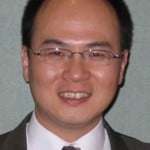 Biomedical Engineering Graduate Seminar: Wan-Ju Li, Phd, Department of Biomedical Engineering, University of Wisconsin-Madison; Friday, October 17; 3:00 in U113 M&M;
Biomedical Engineering Graduate Seminar: Wan-Ju Li, Phd, Department of Biomedical Engineering, University of Wisconsin-Madison; Friday, October 17; 3:00 in U113 M&M;
Sponsored by: Department of Biomedical Engineering and the Biotechnology Research Center (BRC)
Title: Stem Cell-based Musculoskeletal Tissue Regeneration
Mesenchymal stem cells (MSCs) can be isolated from several adult tissues, such as bone marrow, fat, and blood, and cultured in vitro for extensive propagation. These cells are multi-potent, and with proper biochemical or physical cues, they can differentiate into various connective tissue linage cells, such as osteoblast, chondrocyte, adipocyte, and tenocyte. Notably, transplanted allogeneic MSCs can regulate the activity of recipient’s immune cells to reduce the immune response. These unique properties make MSCs an attractive cell source for cell therapy and re-generative medicine applications.
Using MSCs to regenerate cartilage for tissue repair is a promising treatment to osteoarthritis (OA) or other cartilage defects. However, one of the challenges using MSCs for regenerative medicine is that the cells isolated from adult tissues are often composed of heterogeneous cell popu-lations, and the heterogeneity increases the difficulty of using the cells for cartilage regeneration. Another challenge is that MSCs become aged and senescent after several cell passages in vitro culture, limiting the use for clinical applications. To overcome the challenges, we derive MSCs from human embryonic stem cells (hESCs) and study the potential of hESC-MSCs for cartilage regeneration. We compare the phenotype of hESC-MSCs with that of bone marrow-derived MSCs. Flow cytometry analysis shows that MSCs and hESC-MSCs express similar cell surface markers. In terms of the potential for chondrogenesis, the mRNA transcript levels of chondrocyte-related matrix proteins and transcription factors, such as collagens type II, IX, and X, aggrecan, and Sox9, are upregulated in MSCs compared to those in hESC-MSCs during chondrogenesis, suggesting that the current differentiation protocol more effectively induces MSCs into chondrocytes than hESC-MSCs, and an improved differen-tiation protocols should be developed to induce chondrogenesis of hESC-MSCs.
For tissue engineering applications, we demonstrate a unique approach using a biomimetic scaffold, intervertebral disc (IVD) and stem cell coculture, and mechanical stimulation to tissue-engineer a biological IVD substitute. The results show that our approach provides both favorable physical and chemical cues through cell-matrix and cell-cell interactions and mechanobiological induction to enhance IVD generation ex vivo. Taken together, we have shown the potential of using stem cell and nanofabrication technologies to regenerate functional tissue for orthopedic treatment.
Professor Wan-Ju Li is the Principal Investigator of the Musculoskeletal Biology and Regenerative Medicine Laboratory at the University of Wisconsin-Madison in the United States of America. He is also an affiliated faculty member in Cellular and Molecular Biology Program, and Stem Cell and Regenerative Medicine Center. His research interests include stem cell, tissue engineering, nanobiomaterial, and skeletal biology.